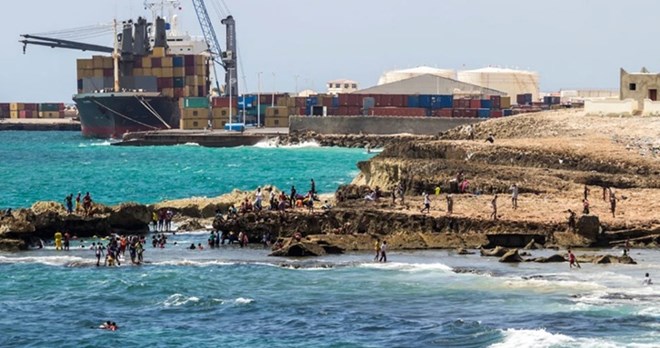
Tuesday May 27, 2025

Mogadishu Port, in the capital of Somalia. Photo: Shutterstock.
Mogadishu (HOL) — Somalia is at risk of forfeiting millions in unspent reform funds unless it accelerates a lagging governance overhaul backed by the African Development Bank.
Eighteen months into the $13 million Institutional Support for Economic Governance Project (ISEGP), the country has used just 15.2 percent of the funds, leaving federal finance officials racing to triple their monthly disbursement rate before the project's deadline in December 2026.
The AfDB's May 2025 report paints a mixed picture: tax revenues rose to 2.8% of GDP in 2023, and Somalia's public-sector accountability score on the Ibrahim Index climbed to 20.1%, passing its 2026 benchmark. But analysts caution those gains stem from temporary boosts—like tariff adjustments and GDP rebasing—not structural reforms.
However, most project outputs are still in the early stages. Only one of 16 outputs—a Medium-Term Revenue Strategy launched in 2024—is complete. The report confirms that the strategy informed Somalia's 2025 revenue forecasts and was developed through consultations with the federal government and key stakeholders.Puntland standoff slows implementation
A key infrastructure component of the ISEGP—modernizing inland revenue offices across Somalia's Federal Member States—has encountered political roadblocks. According to the AfDB's May 2025 report, preliminary designs for these tax offices have been approved by all Federal Member States (FMSs) except Puntland, which has withheld endorsement of the central blueprint.
The delay is attributed to what the report calls "political misunderstandings" between the Federal Government of Somalia (FGS) and Puntland. The federal finance ministry is currently engaging with Puntland officials to address the economic implications of the delays and propose a way forward, with a resolution deadline set for December 31, 2025.
If unresolved, it could jeopardize broader program goals, especially those tied to equitable infrastructure distribution and national revenue unification.
The standoff is particularly consequential: the port city of Bosaso, under Puntland's jurisdiction, accounts for a substantial amount of federal customs revenue. Without Puntland's participation, key project assumptions related to domestic revenue mobilization could fall apart, particularly those embedded in the 2025 revenue forecasts guided by the new Medium-Term Revenue Strategy.
Until the designs are approved, detailed blueprints and bills of quantities (BOQs) for the Puntland office cannot move forward. The consulting firm hired for this component, Ecotech Ltd., began work in August 2024 and completed preliminary consultations with the other FMSs; however, progress in Puntland remains frozen.
Inflation and systemic risks
The project faces a secondary risk from rising global construction-material prices, largely due to trade friction between the United States and China. "Much of the construction materials used in Somalia are sourced from China," the report warns, urging the federal implementation unit to fast-track procurement before prices climb further.
The report confirms that Somalia has fully operationalized the Commonwealth Meridian debt management platform, including ICT upgrades and staff training. However, debt statistics bulletins—16 promised by project end—are flagged as "not on track," and integration with Somalia's national Financial Management Information System (FMIS) system remains incomplete.
On gender, the project sets a target of 20% female participation across all training modules, including debt, procurement, and public investment. Yet the most recent monitoring update confirms that women's participation remains at or near zero across all training indicators.
The AfDB still classifies ISEGP as a "non-potentially problematic project," citing ongoing procurement progress and expected acceleration in 2025. Yet with over UA 8.48 million (approx. $11 million) still undisbursed, donors must decide whether to extend timelines or risk a final-year spending surge that could compromise oversight and delivery.
The ISEGP forms part of a push under Somalia's NDP-9 and Heavily Indebted Poor Countries (HIPC) initiative to rebuild fiscal institutions and secure full debt relief. With political consensus, public trust, and external financing all on the line, the coming year may determine whether the country's most ambitious reform project can meet its goals—or end up as another footnote in Somalia's long aid history.